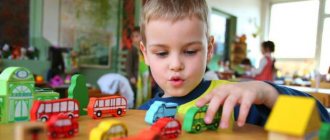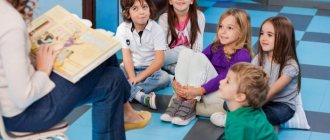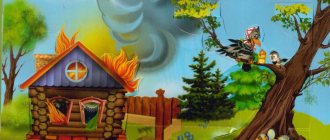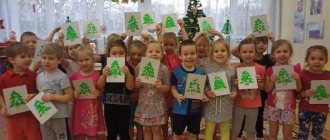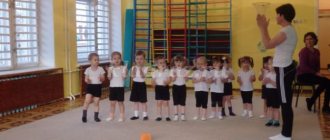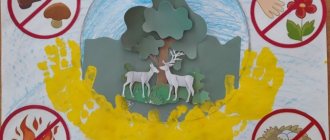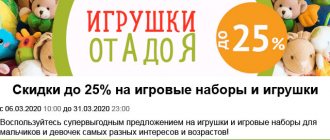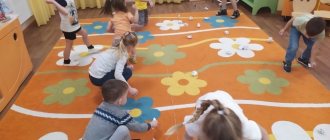Senior group. Senior preschool age. Children 5-6 years old
Play readings as a means of cultivating interest in literary creative activity in children of senior preschool age. In the Federal State Educational Standard, one of the main directions is the speech development of the child, mastering speech as a means of communication and culture; development of children's speech creativity. The highest form of speech development is literary creativity ,...
Abstract of the GCD on fiction in the senior correctional group “Reading the story by N. Kalinina “About Birds”
Goal: development of cognitive interest and expansion of knowledge about wintering birds. Objectives: • to form in children a holistic understanding of seasonal changes in nature; • teach children to listen carefully to the story and answer questions based on the content; • develop dialogical speech; •…
Card index of fiction in the senior group according to the Federal State Educational Standard with goals
Card index of fiction in various educational fields in the senior group According to the program “From birth to school”, ed.
N.E. Veraksy O.O. Contents Author, title Purpose Moral education RNS “The Fox and the Jug” arr. O. Kapitsa Cultivating good feelings; formation of ideas about greed and stupidity RNS “Winged, hairy and oily” arr. I. Karnaukhova Teach children to understand the character and actions of the heroes of X. Mäkel. "Mr. Au" (chapters), trans. from Finnish E. Uspensky rns "Khavroshechka" arr. A. N. Tolstoy Cultivate manifestations of good feelings towards each other; RNS "Bragging Hare" arr. O. Kapitsa To educate the norms of moral behavior rns “The Frog Princess” arr. M. Bulatov Cultivate kindness and a sense of mutual assistance. B. Shergin “Rhymes” Cultivate a respectful attitude towards other people rns “Sivka-burka” arr. M. Bulatov To develop in children the ability to evaluate the actions of heroes, to express their attitude towards them RNS “Finist-Clear Falcon” arr. A. Platonov Cultivate a sense of compassion for others V. Dragunsky “Childhood Friend”, “Top down, diagonally” Cultivate attentiveness, love, compassion for a close comrade S. Mikhalkov “What do you have?” Nenets fairy tale “Cuckoo” arr. K. Sharov To promote kindness, attentiveness and responsiveness to relatives “Goldilocks”, trans. from Czech K. Paustovsky; cultivate the ability to empathize, be generous, and not envy others; develop self-respect and mutual assistance in work. "Three golden hairs of Grandfather the Omniscient", trans. from Czech N. Arosieva (from the collection of fairy tales by K. Ya. Erben). V. Dmitrieva. “Baby and the Bug” (chapters) Feel and understand the character of the images of L. Tolstoy’s literary work “The Bone” Cultivate the moral qualities of the individual: honesty, truthfulness, love for family. L. Tolstoy “The Jump” To awaken in children empathy for the hero of the story N. Nosov. "Living Hat"; To form children's ideas about moral standards with the help of children's literature. S. Georgiev. “I saved Santa Claus” Develop the ability to evaluate one’s own actions and the actions of heroes, cultivate friendliness, and the ability to interact with peers A. Lindgren. “Carlson, who lives on the roof, has arrived again” (chapters, abbr.), trans. with Swedish L. Lungina K. Paustovsky. “The Thief Cat” To cultivate moral qualities: a sense of compassion, empathy Adam Mitskevich “To Friends” To generalize and expand children’s knowledge about such concepts as “friend”, “friendship”, “honesty”, “justice” P. Bazhov “Silver Hoof” To educate a feeling of kindness, caring for the weak R. Kipling. "Little Elephant", trans. from English K. Chukovsky, poems in translation. S. Marshak To foster a culture of behavior, friendship, mutual assistance, care for loved ones V. Kataev. “Tsvetik-semitsvetik” To develop the ability to present the characteristics of one’s personality among peers, reflecting achievements and the reasons for possible difficulties. Child in the family and in society RNS "Khavroshechka" arr. A. N. Tolstoy Introduce different family relationships by Yu. Koval “Grandfather, Grandmother and Alyosha” Form in children an idea of a family as people who live together, love each other, take care of each other. V. Dragunsky “Deniska’s stories” Formation of ideas about the characteristic qualities of boys and girls. A. Gaidar. “Chuk and Gek” (chapters) Learn to assess the relationships between close people in the family, compile characteristics of the heroes of E. Grigoriev’s “Quarrel” Develop the basics of social interaction between boys and girls; a friendly attitude towards the opposite sex A. Barto “Vovka is a kind soul” E. Blaginina “Let’s sit in silence” Continue to form children’s idea of a kind attitude towards their mother A. Usachev “What is etiquette” Continue teaching the culture of verbal communication in kindergarten and at home “Krupenichka” N. Teleshov Cultivate interest in fairy tales, in Russian traditions Self-service, work RNS “Khavroshechka” arr. A. N. Tolstoy To form children’s ideas about a hardworking person K. Chukovsky “Moidodyr” Education of cultural and hygienic skills K. Chukovsky “Fedorino’s grief” rns “At the command of the pike” To consolidate in children the concept of the importance of human labor A. Barto “The grimy girl” » Cultivate neatness and careful attitude towards personal belongings and belongings of Comrade Yu. Tuvim. “A letter to all children on one very important matter,” trans. from Polish S. Mikhalkova Formation of the foundations of security S. Mikhalkov “Uncle Styopa the policeman” Reinforcing the rules of behavior on the streets of the city E. Segal “Cars on our street” Cognitive development of FEMP Reading books Heroes of fairy tales S. Marshak “Numbers” Acquaintance with numbers Acquaintance with the social world G H. Andersen “Snowman” Introduction to New Year’s traditions of different countries S. Mikhalkov “What do you have?” Introduction to the importance of any profession "Wonderful stories about a hare named Lek", tales of the peoples of West Africa, trans. O. Kustova and V. Andreeva; Acquaintance with the characteristics of the peoples of West Africa A. Gaidar “The Tale of a Military Secret, Malchish-Kibalchish and His Firm Word” Continue to expand children’s ideas about the Russian army. Nenets fairy tale “Cuckoo” arr. K. Sharov Acquaintance with the life of the peoples of the far north M. Boroditskaya “Waiting for a brother” To form a desire to take care of children, to develop a sense of responsibility and respect for younger comrades A. Tvardovsky “The Tankman’s Story” To form in children an idea of the feat of the people who stood up for the defense of their Motherland . A. Barto “The Herd Game” Expand children’s knowledge about their kindergarten, draw attention to its history, clarify ideas about the work of kindergarten employees S. Makhotin “Senior group” O. Vysotskaya “Kindergarten” T. Aleksandrova “Kuzka the Brownie” (chapters) Cultivate interest in the life of Russians in ancient times, love for the history of their people M. Isakovsky “Go beyond the seas and oceans” Clarify knowledge about your native country. B. Almazov. “Gorbushka” Introduction to Russian values; Introduction to the natural world rns “Bragging Hare” arr. O. Kapitsa To form children’s caring attitude towards nature, the desire to take part in its conservation and protection. L. Tolstoy. “Lion and Dog”, “Bone”, “Jump” Expand ideas about the life of animals G. Snegirev “Penguin Beach” K. Paustovsky. “Cat Thief” Foster love and respect for nature, kindness; V. Bianchi “Owl” Continue to form an idea of the interconnection and interdependence of living beings, an idea of the literary genre “educational fairy tale”; B. Zakhoder “Gray Star” To cultivate a sense of empathy and love for nature and man, the ability to resist evil S. Yesenin “Bird cherry” To help feel the beauty of nature in R. Kipling’s poem. "Little Elephant", trans. from English K. Chukovsky, poems in translation. S. Marshak Develop fine motor skills of the hands, attention and interest in the animal world and its diversity P. Bazhov “Silver Hoof” Cultivate a sensitive attitude towards animals, love for nature Speech development Development of all aspects of speech Acquaintance with genres Explanation of unfamiliar, outdated words Artistic and aesthetic development Introduction to art V. Konashevich Acquaintance with illustrators I. Bilibin E. Charushin Fine arts activity Drawing illustrations based on works Musical activity P. I. Tchaikovsky “The Nutcracker” (fragments) Acquaintance with the musical depiction of heroes and images of works by P. I. Tchaikovsky “The Seasons” (fragments) N. A. Rimsky-Korsakov “The Tale of Tsar Saltan” (fragments) S. Prokofiev “Peter and the Wolf” Physical development of GCD and leisure activities based on the plots of the works Heroes of the works
Download Card index of fiction in the senior group according to the Federal State Educational Standard
We recommend watching:
Notes for a math lesson in the senior group “Kolobok's Journey” Notes on speech development in the senior group “Poultry” Intellectual Olympiad for senior preschool children in kindergarten Consultation for preschool teachers. Development of sound culture of speech in older children
Similar articles:
Cultivating cognitive interest in social reality in children of senior preschool age
Surprising moments in kindergarten classes. Card index
Kindergarten teacher business card
Presentation of kindergarten for parents
Morning exercises in kindergarten in the preparatory group
Preview:
Summary of a lesson in the senior group on familiarization with fiction.
Reading the Russian folk tale “Khavroshechka”.
Target. Remember Russian folk tales known to children. To introduce the fairy tale “Khavroshechka” (in the adaptation of A.N. Tolstoy), to help remember the initial phrase of the work. Develop the ability to distinguish fairy-tale situations from real ones.
— expand children’s knowledge about Russian folk tales;
- strengthen the ability to distinguish a fairy tale from other literary works;
- teach children to analyze a fairy tale;
- learn to understand the emotional and figurative content of the work.
_ to cultivate a love for Russian folk art;
- cultivate manifestations of good feelings towards each other;
— develop interest in Russian folk tales;
— to introduce children to the origins of Russian culture;
- develop thinking, imagination, visual memory, observation;
— develop children’s cognitive and speech activity, expand their vocabulary;
- enrich children's emotions.
Methods and techniques:
Visual (show, demonstration);
Verbal: Audio recording of a fairy tale and demonstration of illustrative material. Dialogue in roles.
Gaming: organizational moment; physical education, final part
Preliminary work: examining illustrations for fairy tales, toys, reading Russian folk tales, composing descriptive stories based on subject pictures. Working with parents.
Vocabulary work: canvases, liquid,
Preparing for the lesson. Exhibition of Russian folk tales, illustrations for fairy tales, a book with the fairy tale “Khavroshechka”, finger theater.
Let's stand in a circle. Look, what is this?
Educator: This ball is not simple, but magical. He will help us get into the story. To do this you need to say the magic words.
You roll, roll, ball, from the ravine to the bridge,
Just don’t rush too much, point the way to the fairy meadow.
Educator: . And here we are in a fairy meadow. What do you see in the fairy meadow? Books. What are these books about? Are you familiar with these fairy tales? How does a fairy tale usually begin? From what words?
Children: Once upon a time, it happened a long time ago, once in a forest, in some kingdom, etc.
Educator: Guys. What do fairy tales usually talk about?
Children: About the adventures of people and animals, about mysterious and magical events.
Educator: Is it possible to guess from the illustration what this fairy tale is about?
Didactic game “Find out the fairy tale and name the heroes.”
Educator: Today I want to introduce you to a new fairy tale, and
in it you will encounter unfamiliar words: canvases, liquid apples. How do you understand them? (Canvas is handmade linen fabric. Pourable apples are ripe, filled with juice, juicy)
Sit down comfortably and listen to a fairy tale called
Educator: What fairy tale words did you hear in the fairy tale?
Children: Khavroshechka will fit into one ear, come out of the other - everything is ready, liquid apples, silver twigs. The leaves are golden.
Educator: why do you think the fairy tale begins with the words: “There are good people in the world, there are worse people, and there are those who are not ashamed of their brother”?
Children: Because these people took Tiny Khavroshechka and overworked her with work: she weaves and spins, she cleans up, she is responsible for everything. And all the master's children knew was to sit at the gate and watch the street.
Educator: What kind of Khavroshechka do you imagine?
Children: Kind, smart, hard-working
Educator: What were the stepmother and her daughters like?
Children: Angry, envious, cunning.
Educator: Who was Khovroshechka’s friend in this fairy tale?
How did you help Khovroshechka?
Children: Helped her do hard work: (Cow) Khovroshechka will fit into one ear, out of the other, and pick up ready-made canvases.
Educator: How did the stepmother find out about this?
Children: She sent her daughters to follow Khavroshechka and Three-Eyes saw everything, how Khavroshechka got into one ear, and came out of the other, and all the work was done, because her two eyes fell asleep, and the third looked and saw everything.
Educator: Which fairy tale hero did you want to be like?
Hey guys, don't be lazy
Get ready to warm up.
We walk softly, like fox cubs
